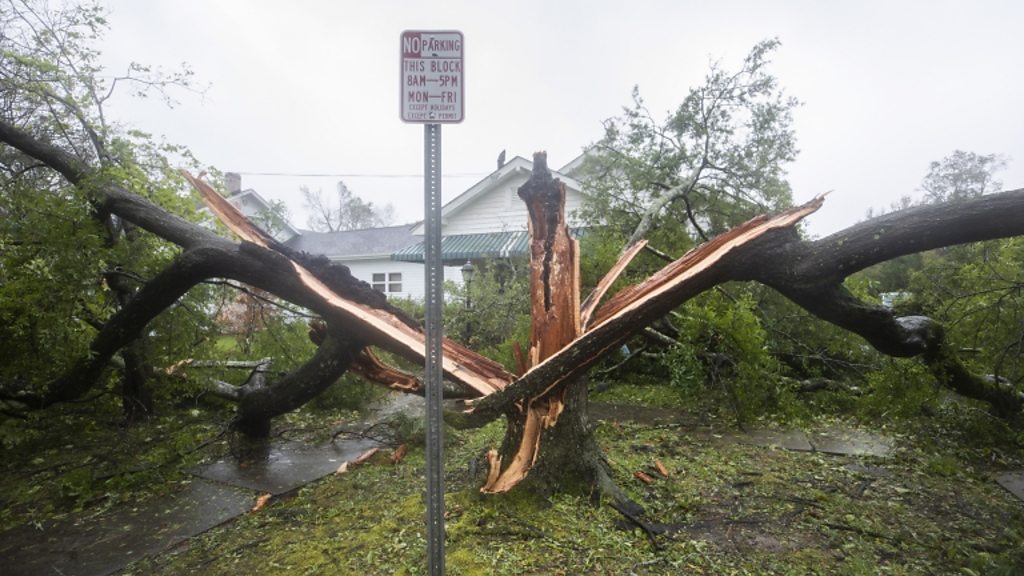US President Donald Trump has declared a disaster in North Carolina where a tropical storm has killed seven amid warnings the worst is far from over.
Florence’s top sustained winds have weakened to 50mph (80km/h), but it is projected to bring further catastrophic flash flooding.
Some towns have already had over 2ft (60cm) of rain, and forecasters warn that totals could hit 3.5ft (1m).
Nearly a million householders have no electricity in the Carolinas.
On the other side of the world, meanwhile, more than a dozen people have died as Typhoon Mangkhut rips through the Philippines.
President Trump’s disaster declaration for eight North Carolina counties frees up federal funding including grants for property repairs and low-cost loans to cover uninsured losses.
The president may travel to the region next week, the White House has said.
All seven deaths from Florence are in North Carolina:
- Two people in Carteret County were the latest to die, emergency services told local media
- A mother and her child were killed in Wilmington when a tree fell on their home on Friday. The infant’s father was taken to hospital for injuries
- A 78-year-old man was electrocuted in Lenoir County while attempting to connect extension cords
- A 77-year-old man in the same county died when he was blown down by high winds while checking on his hunting dogs
- A woman died from cardiac arrest in the town of Hampstead after emergency responders had their route to her blocked by downed trees
On Saturday morning, the 350-mile-wide storm was strolling along at 2mph, unleashing drenching downpours in eastern South Carolina.
About 100 people still need to be rescued in New Bern, North Carolina, where some 4,200 homes have been damaged, the mayor told CNN.
The riverfront city of 30,000 people has been deluged by 10ft of water, the National Weather Service (NWS) reported.
Householders were stranded in their cars, attics and on rooftops.
On Saturday, North Carolina Governor Roy Cooper warned of “epic” levels of rainfall.
“The water is rising fast everywhere, even in places that don’t typically flood,” he said.
- Maps: Where is the storm hitting now?
- In pictures: Hurricane Florence hits
- Coast guard removed for ‘white power sign’
Hundreds of residents have already been plucked to safety from flooded homes in the North Carolina of counties of Beaufort and Craven.
Officials warn Florence could unleash floods inland into early next week.
Between 10-15ins of rain is expected along with storm surges of 2-5ft across the region.
“This rainfall will continue to produce catastrophic flash flooding and prolonged significant river flooding,” said the National Hurricane Center (NHC) in a bulletin.
The Federal Emergency Management Authority said motorists should not attempt to drive through floodwaters.
“Just turn around and don’t drown,” officials said.
The storm is expected to become a tropical depression on Saturday, significantly weakening over the weekend, the NHC said.
But the NWS warned people to stay on guard.
“Don’t be fooled – just because Florence is now a tropical storm doesn’t mean that the impacts no longer exist,” it tweeted on Saturday.
Nearly 950,000 customers have no electricity in the Carolinas, the News & Observer reported.
As many as 2.5 million North Carolina residents could be left without power, the state’s Department of Public Safety said.
About 9,700 National Guard troops and civilians have been deployed with high-water vehicles, helicopters and boats.
More than 22,600 people were housed in 150 North Carolina shelters, such as churches, schools and a basketball arena.
Florence made landfall in Wilmington, North Carolina, on Friday morning as a category one hurricane.
The National Hurricane Center downgraded it to a tropical storm later in the day.
Are you in the area? If it is safe to do so please tell us about your situation by emailing haveyoursay@bbc.co.uk.
Please include a contact number if you are willing to speak to a BBC journalist.
You can also contact us in the following ways:
- WhatsApp: +447555 173285
- Tweet: @BBC_HaveYourSay
- Send pictures/video to yourpics@bbc.co.uk
- Upload your pictures/video here
- Send an SMS or MMS to 61124 or +44 7624 800 100
- Please read our terms and conditions and privacy policy
Or use the form below









